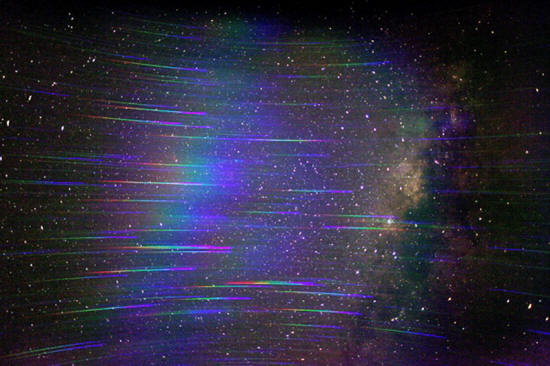|
by Ramin Skibba from Nature Website
These aren't the rogue planets you're looking for. Ron Dantowitz
CCO/NASA
New analyses cut down the estimated number of planets unattached to a star by half.
But some renegade worlds wander across the Milky Way without a host. Two new analyses suggest that Jupiter-sized rogue planets are a lot less common than scientists thought.
The Galaxy is likely home
to around 100 billion of these planets, one study
shows, instead of the 200 billion proposed in 2011.
These occur when a planet passes between Earth and a distant star at just the right angle to - temporarily - act like a cosmic magnifying glass.
It can briefly brighten
the light from the star and provide researchers with information
about the size of the 'lens', or planet, which might not reflect any
light. This technique is currently the only way to spot these giant
rogues. Previous estimates of the number of free-floating planets stemmed from a 2011 analysis of ten microlensing events suggestive of renegade worlds. 1
The authors hypothesized that there could be as many as two rogue worlds for every main-sequence star - one of the most common categories, which includes the Sun.
The 2011 finding flew in the face of how many astronomers thought rogue planets formed. In a binary system where each star hosts its own planets, the gravitational force of one of the stars could disrupt the orbit of a planet and fling it out of the system.
There could be similar effects in a crowded cluster of stars, where one star could eject its neighbor's outer planet.
These and other scenarios could produce some free-floating planets, but probably not hundreds of billions of them, says Sarah Dodson-Robinson, an astronomer at the University of Delaware in Newark.
The reduced estimates have reassured astronomers that their ideas of rogue planet formation aren't so far off the mark.
A rogue's dispute
Many of the suspected 'rogue planets' from the 2011 analysis do actually orbit a star, says Christian Clanton, an astronomer at NASA Ames Research Center in Moffett Field, California, who was one of the conference presenters.
His statistical analysis 2 showed that they probably circle their star at a distance of 1.5 billion kilometers or more - farther than Saturn is from the Sun.
There are perhaps only half as many genuinely rogue worlds as the 2011 analysis estimates, says Clanton, although the planets could still number in the billions.
The 2011 paper looked at data from the Microlensing Observations in Astrophysics project, which uses a telescope in New Zealand.
The authors examined 474 detections of giant planets more massive than Jupiter, of which 10 seemed to be observations of planets that weren't bound to stars.
The team's statistical analysis suggested that the Galaxy is home to roughly 200 billion free-floating worlds.
Some researchers took issue with that interpretation because it was based on so few sightings of potential rogue planets, says Jennifer Yee, an astrophysicist at the Harvard-Smithsonian Center for Astrophysics in Cambridge, Massachusetts.
But the field had to wait for more data from better-situated telescopes to narrow down the true number.
Those observations came from the Optical Gravitational Lensing Experiment (OGLE), which uses a telescope in northern Chile - a site with better weather and atmospheric conditions for astronomy than New Zealand.
When Przemek Mróz, an astronomer at Warsaw University Observatory in Poland, and his colleagues analyzed the data, they didn't find evidence for a large population of rogue planets.
Mróz - whose team is in the process of publishing its findings - points out that flaring stars, or stars whose brightness fluctuates could mimic the microlensing effects of a renegade world.
Astronomers are looking forward to even better estimates when NASA's Wide Field Infrared Survey Telescope (WFIRST) launches in the mid-2020s.
Once WFIRST settles into position, it will collect much more sensitive microlensing observations of planets. It will even be able to detect worlds that are smaller than Mars.
The truth about rogue planets is out there, and WFIRST will help astronomers to find it.
References
|


